Plagiarism Detection: Methods, Challenges, and Future Directions
VerifiedAdded on 2022/11/15
|19
|4527
|420
Report
AI Summary
This report delves into the critical issue of plagiarism detection, exploring its increasing significance in the academic and research landscape. It begins by defining plagiarism, outlining its various forms (copy and paste, style, idea, word switch, and metaphor plagiarism), and emphasizing the impact of the internet and digital libraries on its prevalence. The core of the report focuses on the application of Singular Value Decomposition (SVD) as a key technique for plagiarism detection, particularly in the context of clustering documents to identify similarities. It explains the SVD process, including the use of the SVDLIBC software and the construction of matrices (U, Σ, VT) for analysis. The report also discusses the rationale behind using SVD to reduce the search time for plagiarized content, and the potential use of neural networks for local matching and differentiation. The problem statement highlights the challenges of plagiarism detection, the limitations of existing tools, and the importance of finding the location of similar content. It examines string and vector similarity metrics used in plagiarism detection, and the need for scalable solutions. The report concludes by emphasizing the ongoing need to address plagiarism, promote academic integrity, and explore advanced detection methods.
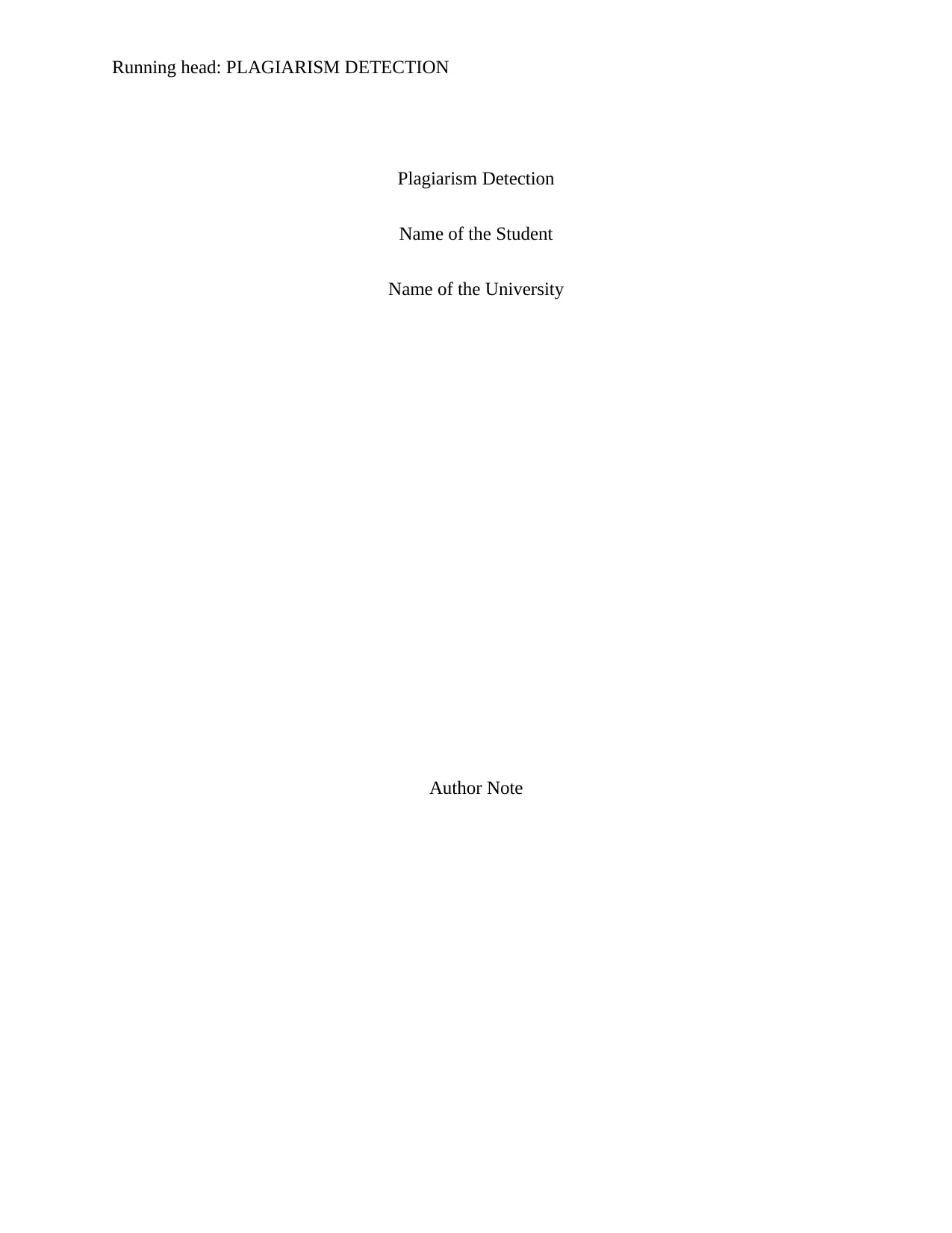
Running head: PLAGIARISM DETECTION
Plagiarism Detection
Name of the Student
Name of the University
Author Note
Plagiarism Detection
Name of the Student
Name of the University
Author Note
Paraphrase This Document
Need a fresh take? Get an instant paraphrase of this document with our AI Paraphraser
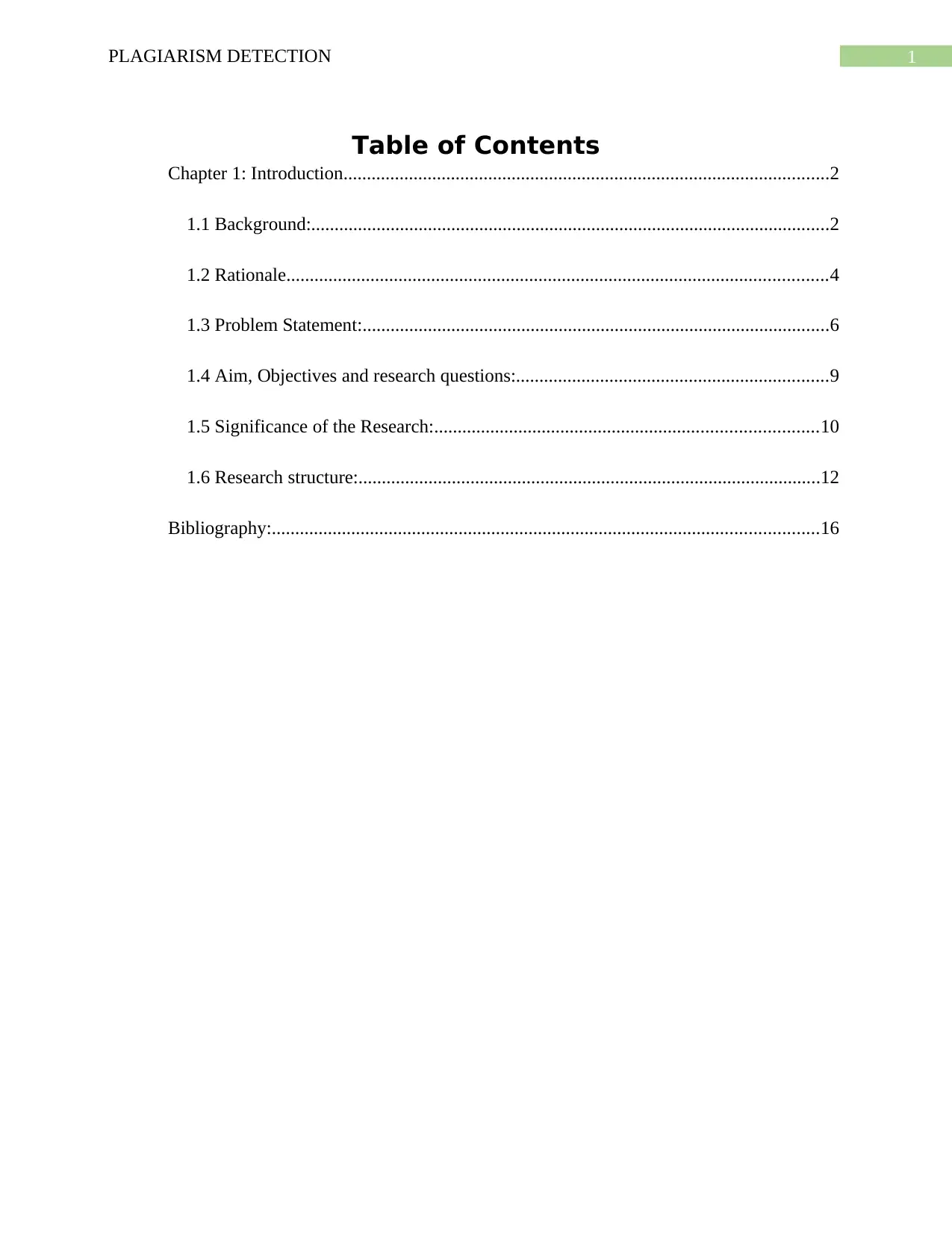
1PLAGIARISM DETECTION
Table of Contents
Chapter 1: Introduction........................................................................................................2
1.1 Background:...............................................................................................................2
1.2 Rationale....................................................................................................................4
1.3 Problem Statement:....................................................................................................6
1.4 Aim, Objectives and research questions:...................................................................9
1.5 Significance of the Research:..................................................................................10
1.6 Research structure:...................................................................................................12
Bibliography:.....................................................................................................................16
Table of Contents
Chapter 1: Introduction........................................................................................................2
1.1 Background:...............................................................................................................2
1.2 Rationale....................................................................................................................4
1.3 Problem Statement:....................................................................................................6
1.4 Aim, Objectives and research questions:...................................................................9
1.5 Significance of the Research:..................................................................................10
1.6 Research structure:...................................................................................................12
Bibliography:.....................................................................................................................16
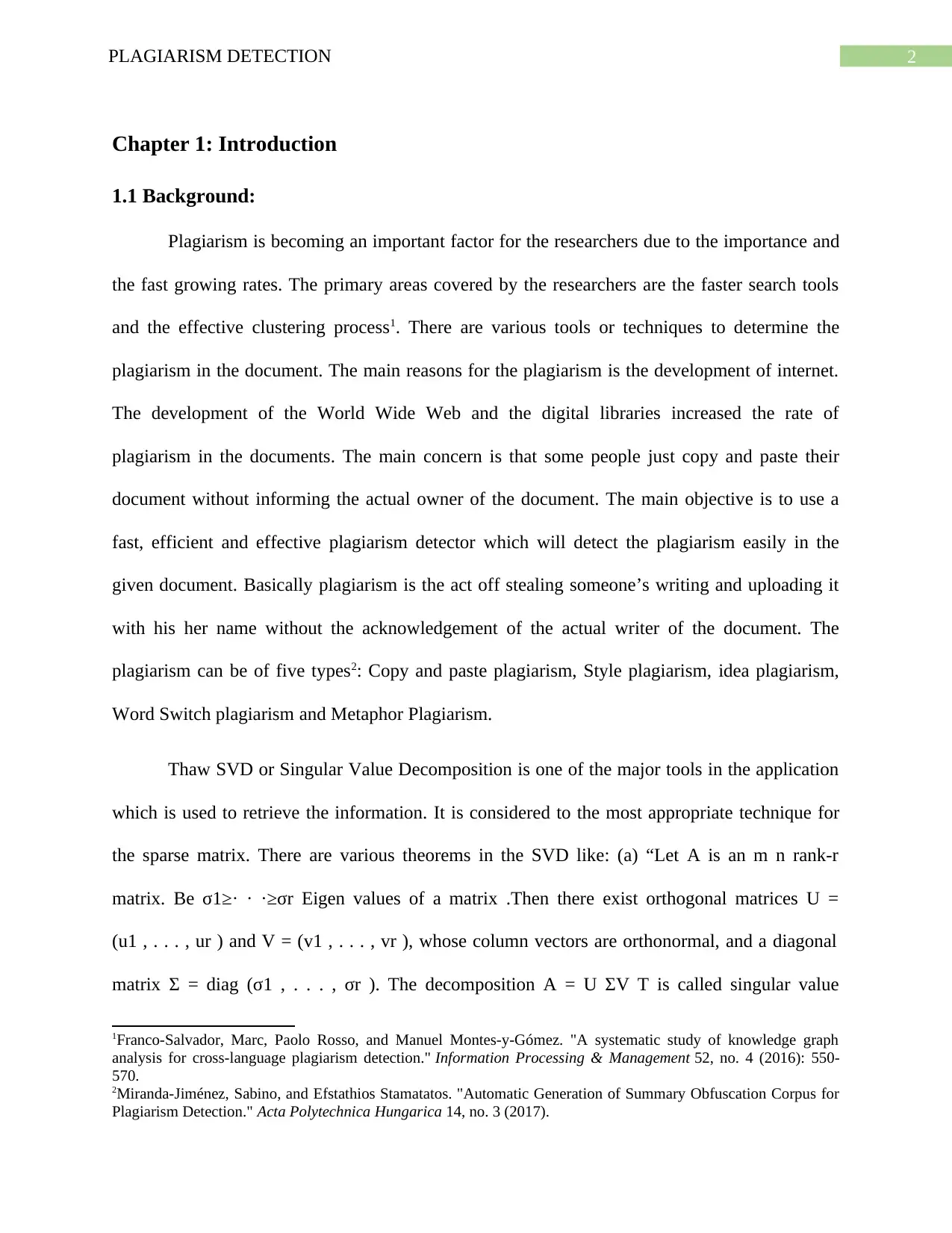
2PLAGIARISM DETECTION
Chapter 1: Introduction
1.1 Background:
Plagiarism is becoming an important factor for the researchers due to the importance and
the fast growing rates. The primary areas covered by the researchers are the faster search tools
and the effective clustering process1. There are various tools or techniques to determine the
plagiarism in the document. The main reasons for the plagiarism is the development of internet.
The development of the World Wide Web and the digital libraries increased the rate of
plagiarism in the documents. The main concern is that some people just copy and paste their
document without informing the actual owner of the document. The main objective is to use a
fast, efficient and effective plagiarism detector which will detect the plagiarism easily in the
given document. Basically plagiarism is the act off stealing someone’s writing and uploading it
with his her name without the acknowledgement of the actual writer of the document. The
plagiarism can be of five types2: Copy and paste plagiarism, Style plagiarism, idea plagiarism,
Word Switch plagiarism and Metaphor Plagiarism.
Thaw SVD or Singular Value Decomposition is one of the major tools in the application
which is used to retrieve the information. It is considered to the most appropriate technique for
the sparse matrix. There are various theorems in the SVD like: (a) “Let A is an m n rank-r
matrix. Be σ1≥· · ·≥σr Eigen values of a matrix .Then there exist orthogonal matrices U =
(u1 , . . . , ur ) and V = (v1 , . . . , vr ), whose column vectors are orthonormal, and a diagonal
matrix Σ = diag (σ1 , . . . , σr ). The decomposition A = U ΣV T is called singular value
1Franco-Salvador, Marc, Paolo Rosso, and Manuel Montes-y-Gómez. "A systematic study of knowledge graph
analysis for cross-language plagiarism detection." Information Processing & Management 52, no. 4 (2016): 550-
570.
2Miranda-Jiménez, Sabino, and Efstathios Stamatatos. "Automatic Generation of Summary Obfuscation Corpus for
Plagiarism Detection." Acta Polytechnica Hungarica 14, no. 3 (2017).
Chapter 1: Introduction
1.1 Background:
Plagiarism is becoming an important factor for the researchers due to the importance and
the fast growing rates. The primary areas covered by the researchers are the faster search tools
and the effective clustering process1. There are various tools or techniques to determine the
plagiarism in the document. The main reasons for the plagiarism is the development of internet.
The development of the World Wide Web and the digital libraries increased the rate of
plagiarism in the documents. The main concern is that some people just copy and paste their
document without informing the actual owner of the document. The main objective is to use a
fast, efficient and effective plagiarism detector which will detect the plagiarism easily in the
given document. Basically plagiarism is the act off stealing someone’s writing and uploading it
with his her name without the acknowledgement of the actual writer of the document. The
plagiarism can be of five types2: Copy and paste plagiarism, Style plagiarism, idea plagiarism,
Word Switch plagiarism and Metaphor Plagiarism.
Thaw SVD or Singular Value Decomposition is one of the major tools in the application
which is used to retrieve the information. It is considered to the most appropriate technique for
the sparse matrix. There are various theorems in the SVD like: (a) “Let A is an m n rank-r
matrix. Be σ1≥· · ·≥σr Eigen values of a matrix .Then there exist orthogonal matrices U =
(u1 , . . . , ur ) and V = (v1 , . . . , vr ), whose column vectors are orthonormal, and a diagonal
matrix Σ = diag (σ1 , . . . , σr ). The decomposition A = U ΣV T is called singular value
1Franco-Salvador, Marc, Paolo Rosso, and Manuel Montes-y-Gómez. "A systematic study of knowledge graph
analysis for cross-language plagiarism detection." Information Processing & Management 52, no. 4 (2016): 550-
570.
2Miranda-Jiménez, Sabino, and Efstathios Stamatatos. "Automatic Generation of Summary Obfuscation Corpus for
Plagiarism Detection." Acta Polytechnica Hungarica 14, no. 3 (2017).
⊘ This is a preview!⊘
Do you want full access?
Subscribe today to unlock all pages.

Trusted by 1+ million students worldwide
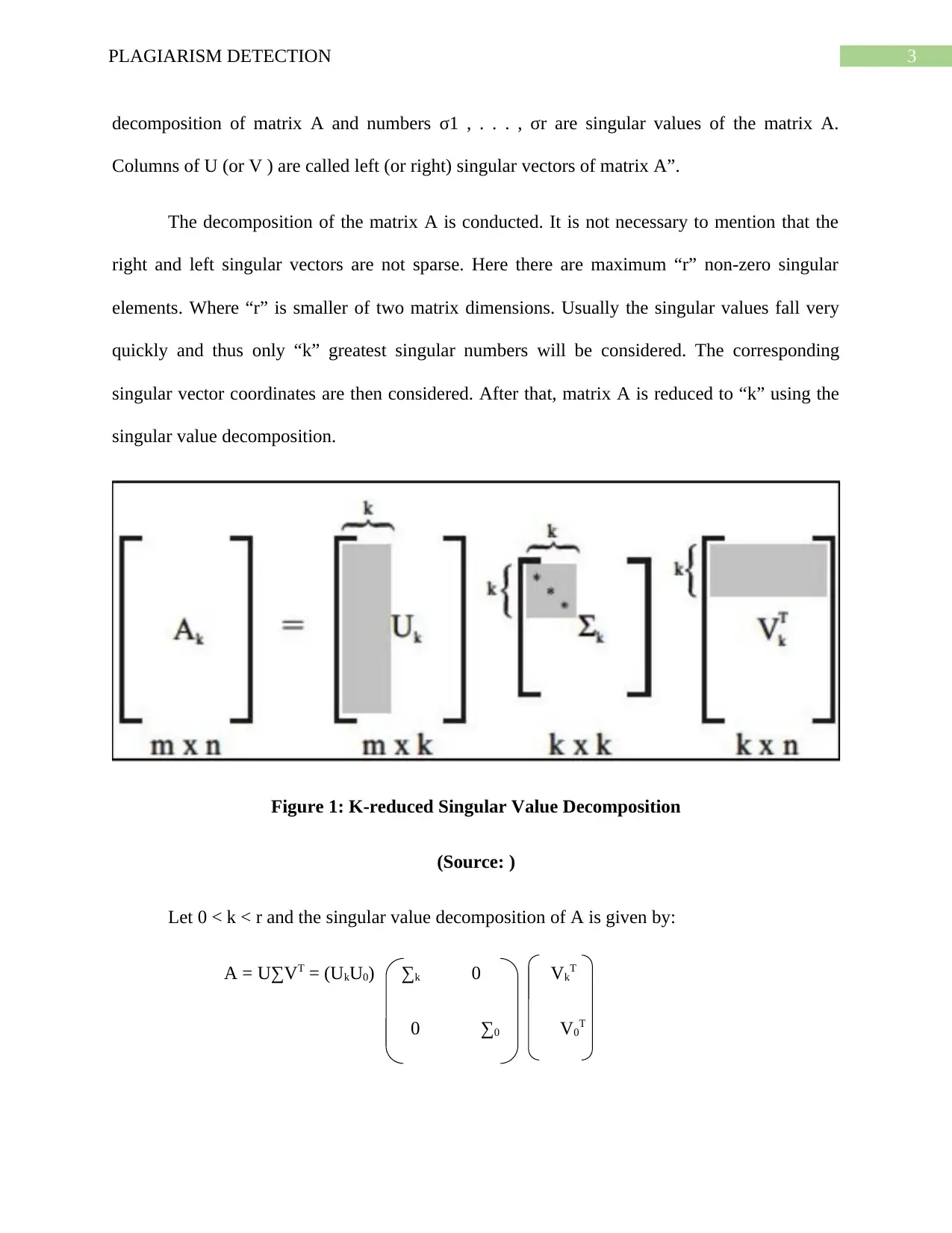
3PLAGIARISM DETECTION
decomposition of matrix A and numbers σ1 , . . . , σr are singular values of the matrix A.
Columns of U (or V ) are called left (or right) singular vectors of matrix A”.
The decomposition of the matrix A is conducted. It is not necessary to mention that the
right and left singular vectors are not sparse. Here there are maximum “r” non-zero singular
elements. Where “r” is smaller of two matrix dimensions. Usually the singular values fall very
quickly and thus only “k” greatest singular numbers will be considered. The corresponding
singular vector coordinates are then considered. After that, matrix A is reduced to “k” using the
singular value decomposition.
Figure 1: K-reduced Singular Value Decomposition
(Source: )
Let 0 < k < r and the singular value decomposition of A is given by:
A = U∑VT = (UkU0) ∑k 0 VkT
0 ∑0 V0T
decomposition of matrix A and numbers σ1 , . . . , σr are singular values of the matrix A.
Columns of U (or V ) are called left (or right) singular vectors of matrix A”.
The decomposition of the matrix A is conducted. It is not necessary to mention that the
right and left singular vectors are not sparse. Here there are maximum “r” non-zero singular
elements. Where “r” is smaller of two matrix dimensions. Usually the singular values fall very
quickly and thus only “k” greatest singular numbers will be considered. The corresponding
singular vector coordinates are then considered. After that, matrix A is reduced to “k” using the
singular value decomposition.
Figure 1: K-reduced Singular Value Decomposition
(Source: )
Let 0 < k < r and the singular value decomposition of A is given by:
A = U∑VT = (UkU0) ∑k 0 VkT
0 ∑0 V0T
Paraphrase This Document
Need a fresh take? Get an instant paraphrase of this document with our AI Paraphraser
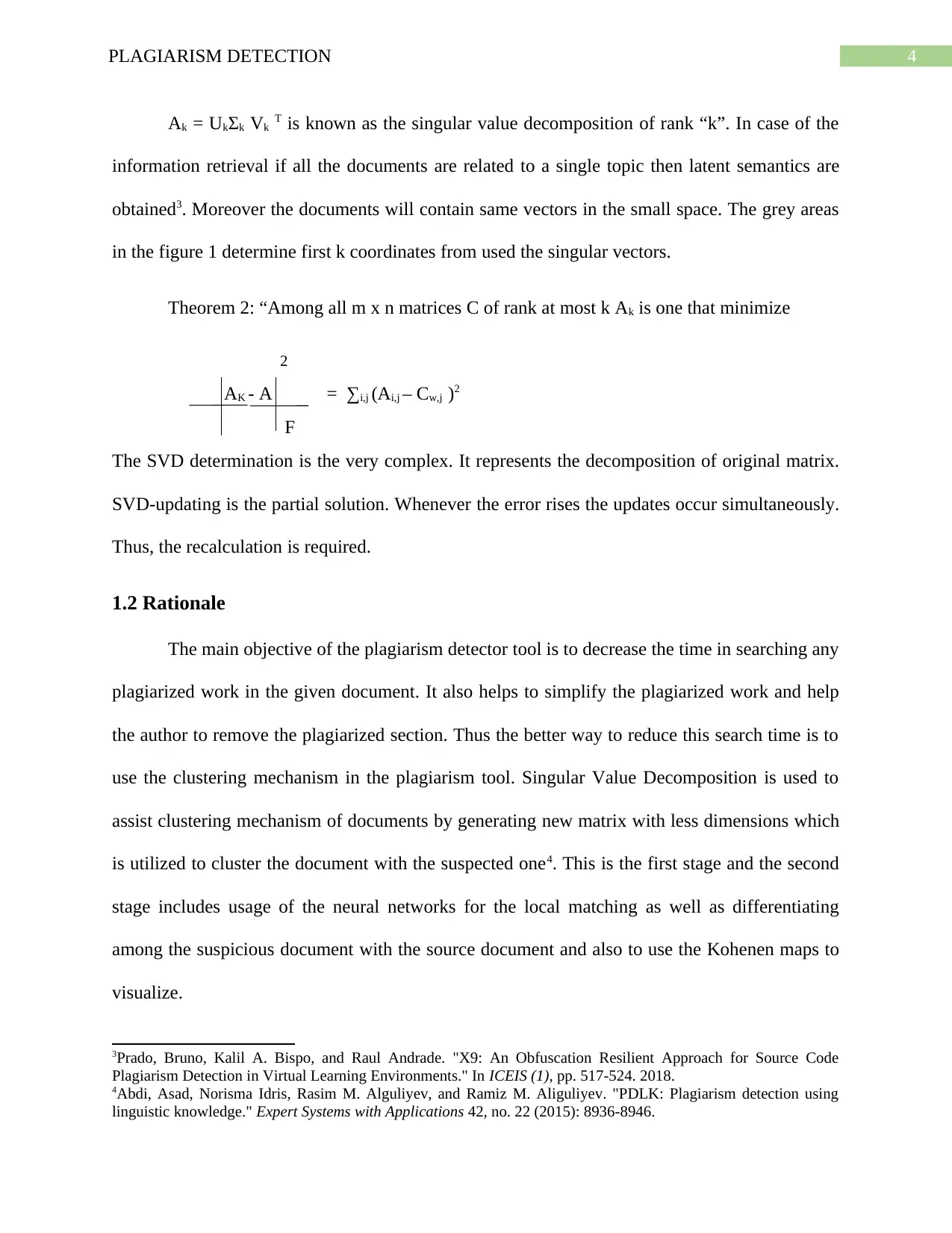
4PLAGIARISM DETECTION
Ak = UkΣk Vk T is known as the singular value decomposition of rank “k”. In case of the
information retrieval if all the documents are related to a single topic then latent semantics are
obtained3. Moreover the documents will contain same vectors in the small space. The grey areas
in the figure 1 determine first k coordinates from used the singular vectors.
Theorem 2: “Among all m x n matrices C of rank at most k Ak is one that minimize
2
AK - A = ∑i,j (Ai,j – Cw,j )2
F
The SVD determination is the very complex. It represents the decomposition of original matrix.
SVD-updating is the partial solution. Whenever the error rises the updates occur simultaneously.
Thus, the recalculation is required.
1.2 Rationale
The main objective of the plagiarism detector tool is to decrease the time in searching any
plagiarized work in the given document. It also helps to simplify the plagiarized work and help
the author to remove the plagiarized section. Thus the better way to reduce this search time is to
use the clustering mechanism in the plagiarism tool. Singular Value Decomposition is used to
assist clustering mechanism of documents by generating new matrix with less dimensions which
is utilized to cluster the document with the suspected one4. This is the first stage and the second
stage includes usage of the neural networks for the local matching as well as differentiating
among the suspicious document with the source document and also to use the Kohenen maps to
visualize.
3Prado, Bruno, Kalil A. Bispo, and Raul Andrade. "X9: An Obfuscation Resilient Approach for Source Code
Plagiarism Detection in Virtual Learning Environments." In ICEIS (1), pp. 517-524. 2018.
4Abdi, Asad, Norisma Idris, Rasim M. Alguliyev, and Ramiz M. Aliguliyev. "PDLK: Plagiarism detection using
linguistic knowledge." Expert Systems with Applications 42, no. 22 (2015): 8936-8946.
Ak = UkΣk Vk T is known as the singular value decomposition of rank “k”. In case of the
information retrieval if all the documents are related to a single topic then latent semantics are
obtained3. Moreover the documents will contain same vectors in the small space. The grey areas
in the figure 1 determine first k coordinates from used the singular vectors.
Theorem 2: “Among all m x n matrices C of rank at most k Ak is one that minimize
2
AK - A = ∑i,j (Ai,j – Cw,j )2
F
The SVD determination is the very complex. It represents the decomposition of original matrix.
SVD-updating is the partial solution. Whenever the error rises the updates occur simultaneously.
Thus, the recalculation is required.
1.2 Rationale
The main objective of the plagiarism detector tool is to decrease the time in searching any
plagiarized work in the given document. It also helps to simplify the plagiarized work and help
the author to remove the plagiarized section. Thus the better way to reduce this search time is to
use the clustering mechanism in the plagiarism tool. Singular Value Decomposition is used to
assist clustering mechanism of documents by generating new matrix with less dimensions which
is utilized to cluster the document with the suspected one4. This is the first stage and the second
stage includes usage of the neural networks for the local matching as well as differentiating
among the suspicious document with the source document and also to use the Kohenen maps to
visualize.
3Prado, Bruno, Kalil A. Bispo, and Raul Andrade. "X9: An Obfuscation Resilient Approach for Source Code
Plagiarism Detection in Virtual Learning Environments." In ICEIS (1), pp. 517-524. 2018.
4Abdi, Asad, Norisma Idris, Rasim M. Alguliyev, and Ramiz M. Aliguliyev. "PDLK: Plagiarism detection using
linguistic knowledge." Expert Systems with Applications 42, no. 22 (2015): 8936-8946.
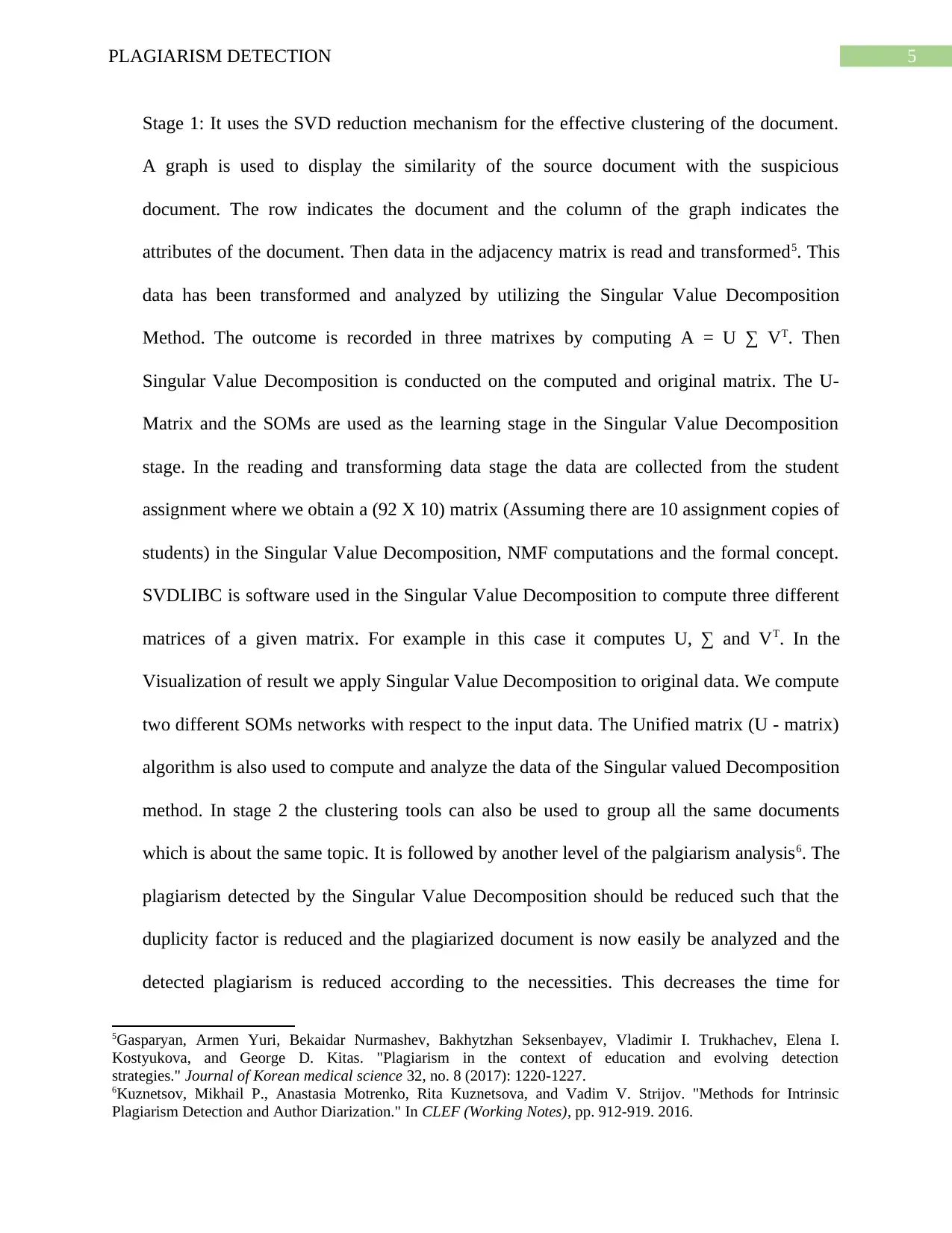
5PLAGIARISM DETECTION
Stage 1: It uses the SVD reduction mechanism for the effective clustering of the document.
A graph is used to display the similarity of the source document with the suspicious
document. The row indicates the document and the column of the graph indicates the
attributes of the document. Then data in the adjacency matrix is read and transformed5. This
data has been transformed and analyzed by utilizing the Singular Value Decomposition
Method. The outcome is recorded in three matrixes by computing A = U ∑ VT. Then
Singular Value Decomposition is conducted on the computed and original matrix. The U-
Matrix and the SOMs are used as the learning stage in the Singular Value Decomposition
stage. In the reading and transforming data stage the data are collected from the student
assignment where we obtain a (92 X 10) matrix (Assuming there are 10 assignment copies of
students) in the Singular Value Decomposition, NMF computations and the formal concept.
SVDLIBC is software used in the Singular Value Decomposition to compute three different
matrices of a given matrix. For example in this case it computes U, ∑ and VT. In the
Visualization of result we apply Singular Value Decomposition to original data. We compute
two different SOMs networks with respect to the input data. The Unified matrix (U - matrix)
algorithm is also used to compute and analyze the data of the Singular valued Decomposition
method. In stage 2 the clustering tools can also be used to group all the same documents
which is about the same topic. It is followed by another level of the palgiarism analysis6. The
plagiarism detected by the Singular Value Decomposition should be reduced such that the
duplicity factor is reduced and the plagiarized document is now easily be analyzed and the
detected plagiarism is reduced according to the necessities. This decreases the time for
5Gasparyan, Armen Yuri, Bekaidar Nurmashev, Bakhytzhan Seksenbayev, Vladimir I. Trukhachev, Elena I.
Kostyukova, and George D. Kitas. "Plagiarism in the context of education and evolving detection
strategies." Journal of Korean medical science 32, no. 8 (2017): 1220-1227.
6Kuznetsov, Mikhail P., Anastasia Motrenko, Rita Kuznetsova, and Vadim V. Strijov. "Methods for Intrinsic
Plagiarism Detection and Author Diarization." In CLEF (Working Notes), pp. 912-919. 2016.
Stage 1: It uses the SVD reduction mechanism for the effective clustering of the document.
A graph is used to display the similarity of the source document with the suspicious
document. The row indicates the document and the column of the graph indicates the
attributes of the document. Then data in the adjacency matrix is read and transformed5. This
data has been transformed and analyzed by utilizing the Singular Value Decomposition
Method. The outcome is recorded in three matrixes by computing A = U ∑ VT. Then
Singular Value Decomposition is conducted on the computed and original matrix. The U-
Matrix and the SOMs are used as the learning stage in the Singular Value Decomposition
stage. In the reading and transforming data stage the data are collected from the student
assignment where we obtain a (92 X 10) matrix (Assuming there are 10 assignment copies of
students) in the Singular Value Decomposition, NMF computations and the formal concept.
SVDLIBC is software used in the Singular Value Decomposition to compute three different
matrices of a given matrix. For example in this case it computes U, ∑ and VT. In the
Visualization of result we apply Singular Value Decomposition to original data. We compute
two different SOMs networks with respect to the input data. The Unified matrix (U - matrix)
algorithm is also used to compute and analyze the data of the Singular valued Decomposition
method. In stage 2 the clustering tools can also be used to group all the same documents
which is about the same topic. It is followed by another level of the palgiarism analysis6. The
plagiarism detected by the Singular Value Decomposition should be reduced such that the
duplicity factor is reduced and the plagiarized document is now easily be analyzed and the
detected plagiarism is reduced according to the necessities. This decreases the time for
5Gasparyan, Armen Yuri, Bekaidar Nurmashev, Bakhytzhan Seksenbayev, Vladimir I. Trukhachev, Elena I.
Kostyukova, and George D. Kitas. "Plagiarism in the context of education and evolving detection
strategies." Journal of Korean medical science 32, no. 8 (2017): 1220-1227.
6Kuznetsov, Mikhail P., Anastasia Motrenko, Rita Kuznetsova, and Vadim V. Strijov. "Methods for Intrinsic
Plagiarism Detection and Author Diarization." In CLEF (Working Notes), pp. 912-919. 2016.
⊘ This is a preview!⊘
Do you want full access?
Subscribe today to unlock all pages.

Trusted by 1+ million students worldwide
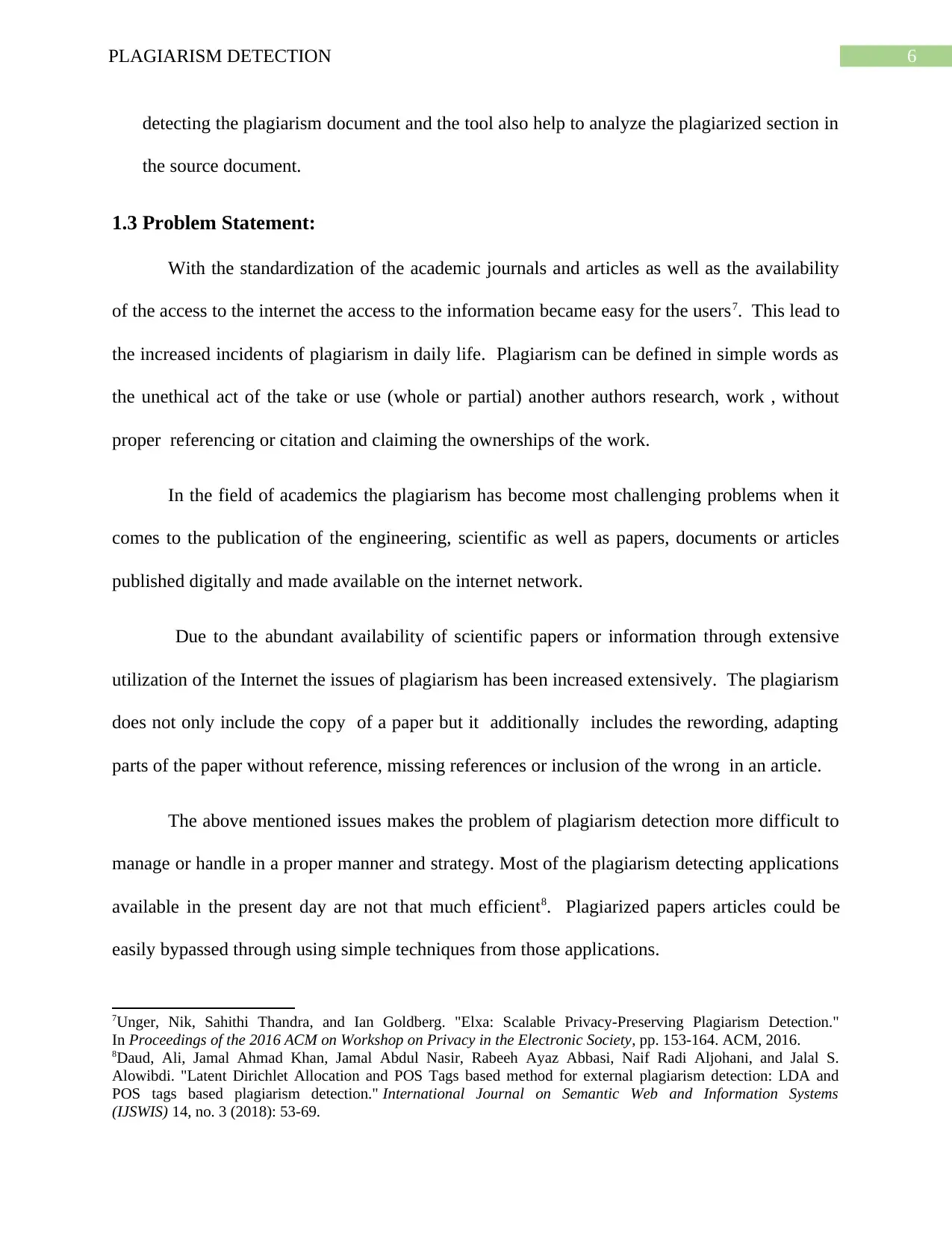
6PLAGIARISM DETECTION
detecting the plagiarism document and the tool also help to analyze the plagiarized section in
the source document.
1.3 Problem Statement:
With the standardization of the academic journals and articles as well as the availability
of the access to the internet the access to the information became easy for the users7. This lead to
the increased incidents of plagiarism in daily life. Plagiarism can be defined in simple words as
the unethical act of the take or use (whole or partial) another authors research, work , without
proper referencing or citation and claiming the ownerships of the work.
In the field of academics the plagiarism has become most challenging problems when it
comes to the publication of the engineering, scientific as well as papers, documents or articles
published digitally and made available on the internet network.
Due to the abundant availability of scientific papers or information through extensive
utilization of the Internet the issues of plagiarism has been increased extensively. The plagiarism
does not only include the copy of a paper but it additionally includes the rewording, adapting
parts of the paper without reference, missing references or inclusion of the wrong in an article.
The above mentioned issues makes the problem of plagiarism detection more difficult to
manage or handle in a proper manner and strategy. Most of the plagiarism detecting applications
available in the present day are not that much efficient8. Plagiarized papers articles could be
easily bypassed through using simple techniques from those applications.
7Unger, Nik, Sahithi Thandra, and Ian Goldberg. "Elxa: Scalable Privacy-Preserving Plagiarism Detection."
In Proceedings of the 2016 ACM on Workshop on Privacy in the Electronic Society, pp. 153-164. ACM, 2016.
8Daud, Ali, Jamal Ahmad Khan, Jamal Abdul Nasir, Rabeeh Ayaz Abbasi, Naif Radi Aljohani, and Jalal S.
Alowibdi. "Latent Dirichlet Allocation and POS Tags based method for external plagiarism detection: LDA and
POS tags based plagiarism detection." International Journal on Semantic Web and Information Systems
(IJSWIS) 14, no. 3 (2018): 53-69.
detecting the plagiarism document and the tool also help to analyze the plagiarized section in
the source document.
1.3 Problem Statement:
With the standardization of the academic journals and articles as well as the availability
of the access to the internet the access to the information became easy for the users7. This lead to
the increased incidents of plagiarism in daily life. Plagiarism can be defined in simple words as
the unethical act of the take or use (whole or partial) another authors research, work , without
proper referencing or citation and claiming the ownerships of the work.
In the field of academics the plagiarism has become most challenging problems when it
comes to the publication of the engineering, scientific as well as papers, documents or articles
published digitally and made available on the internet network.
Due to the abundant availability of scientific papers or information through extensive
utilization of the Internet the issues of plagiarism has been increased extensively. The plagiarism
does not only include the copy of a paper but it additionally includes the rewording, adapting
parts of the paper without reference, missing references or inclusion of the wrong in an article.
The above mentioned issues makes the problem of plagiarism detection more difficult to
manage or handle in a proper manner and strategy. Most of the plagiarism detecting applications
available in the present day are not that much efficient8. Plagiarized papers articles could be
easily bypassed through using simple techniques from those applications.
7Unger, Nik, Sahithi Thandra, and Ian Goldberg. "Elxa: Scalable Privacy-Preserving Plagiarism Detection."
In Proceedings of the 2016 ACM on Workshop on Privacy in the Electronic Society, pp. 153-164. ACM, 2016.
8Daud, Ali, Jamal Ahmad Khan, Jamal Abdul Nasir, Rabeeh Ayaz Abbasi, Naif Radi Aljohani, and Jalal S.
Alowibdi. "Latent Dirichlet Allocation and POS Tags based method for external plagiarism detection: LDA and
POS tags based plagiarism detection." International Journal on Semantic Web and Information Systems
(IJSWIS) 14, no. 3 (2018): 53-69.
Paraphrase This Document
Need a fresh take? Get an instant paraphrase of this document with our AI Paraphraser
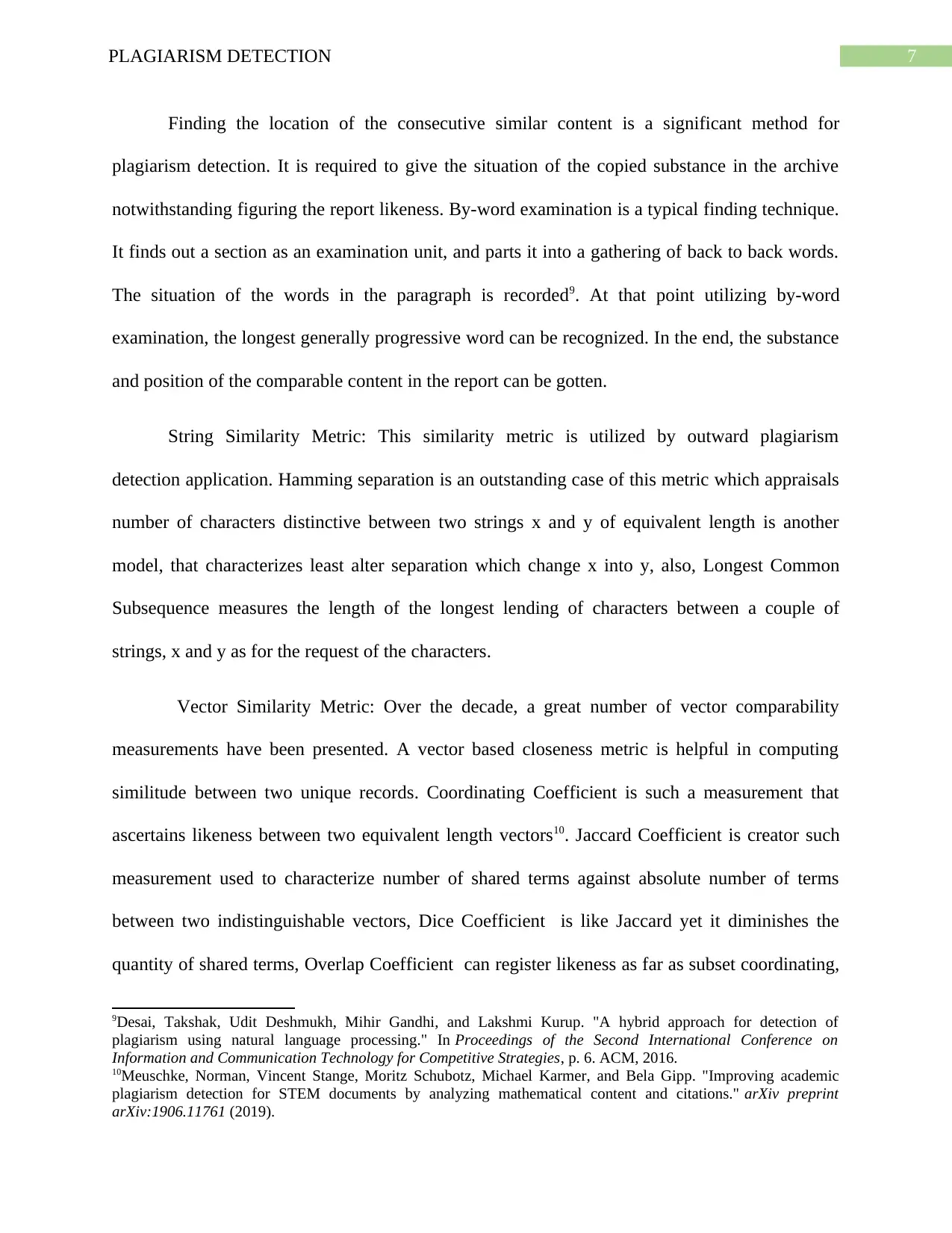
7PLAGIARISM DETECTION
Finding the location of the consecutive similar content is a significant method for
plagiarism detection. It is required to give the situation of the copied substance in the archive
notwithstanding figuring the report likeness. By-word examination is a typical finding technique.
It finds out a section as an examination unit, and parts it into a gathering of back to back words.
The situation of the words in the paragraph is recorded9. At that point utilizing by-word
examination, the longest generally progressive word can be recognized. In the end, the substance
and position of the comparable content in the report can be gotten.
String Similarity Metric: This similarity metric is utilized by outward plagiarism
detection application. Hamming separation is an outstanding case of this metric which appraisals
number of characters distinctive between two strings x and y of equivalent length is another
model, that characterizes least alter separation which change x into y, also, Longest Common
Subsequence measures the length of the longest lending of characters between a couple of
strings, x and y as for the request of the characters.
Vector Similarity Metric: Over the decade, a great number of vector comparability
measurements have been presented. A vector based closeness metric is helpful in computing
similitude between two unique records. Coordinating Coefficient is such a measurement that
ascertains likeness between two equivalent length vectors10. Jaccard Coefficient is creator such
measurement used to characterize number of shared terms against absolute number of terms
between two indistinguishable vectors, Dice Coefficient is like Jaccard yet it diminishes the
quantity of shared terms, Overlap Coefficient can register likeness as far as subset coordinating,
9Desai, Takshak, Udit Deshmukh, Mihir Gandhi, and Lakshmi Kurup. "A hybrid approach for detection of
plagiarism using natural language processing." In Proceedings of the Second International Conference on
Information and Communication Technology for Competitive Strategies, p. 6. ACM, 2016.
10Meuschke, Norman, Vincent Stange, Moritz Schubotz, Michael Karmer, and Bela Gipp. "Improving academic
plagiarism detection for STEM documents by analyzing mathematical content and citations." arXiv preprint
arXiv:1906.11761 (2019).
Finding the location of the consecutive similar content is a significant method for
plagiarism detection. It is required to give the situation of the copied substance in the archive
notwithstanding figuring the report likeness. By-word examination is a typical finding technique.
It finds out a section as an examination unit, and parts it into a gathering of back to back words.
The situation of the words in the paragraph is recorded9. At that point utilizing by-word
examination, the longest generally progressive word can be recognized. In the end, the substance
and position of the comparable content in the report can be gotten.
String Similarity Metric: This similarity metric is utilized by outward plagiarism
detection application. Hamming separation is an outstanding case of this metric which appraisals
number of characters distinctive between two strings x and y of equivalent length is another
model, that characterizes least alter separation which change x into y, also, Longest Common
Subsequence measures the length of the longest lending of characters between a couple of
strings, x and y as for the request of the characters.
Vector Similarity Metric: Over the decade, a great number of vector comparability
measurements have been presented. A vector based closeness metric is helpful in computing
similitude between two unique records. Coordinating Coefficient is such a measurement that
ascertains likeness between two equivalent length vectors10. Jaccard Coefficient is creator such
measurement used to characterize number of shared terms against absolute number of terms
between two indistinguishable vectors, Dice Coefficient is like Jaccard yet it diminishes the
quantity of shared terms, Overlap Coefficient can register likeness as far as subset coordinating,
9Desai, Takshak, Udit Deshmukh, Mihir Gandhi, and Lakshmi Kurup. "A hybrid approach for detection of
plagiarism using natural language processing." In Proceedings of the Second International Conference on
Information and Communication Technology for Competitive Strategies, p. 6. ACM, 2016.
10Meuschke, Norman, Vincent Stange, Moritz Schubotz, Michael Karmer, and Bela Gipp. "Improving academic
plagiarism detection for STEM documents by analyzing mathematical content and citations." arXiv preprint
arXiv:1906.11761 (2019).
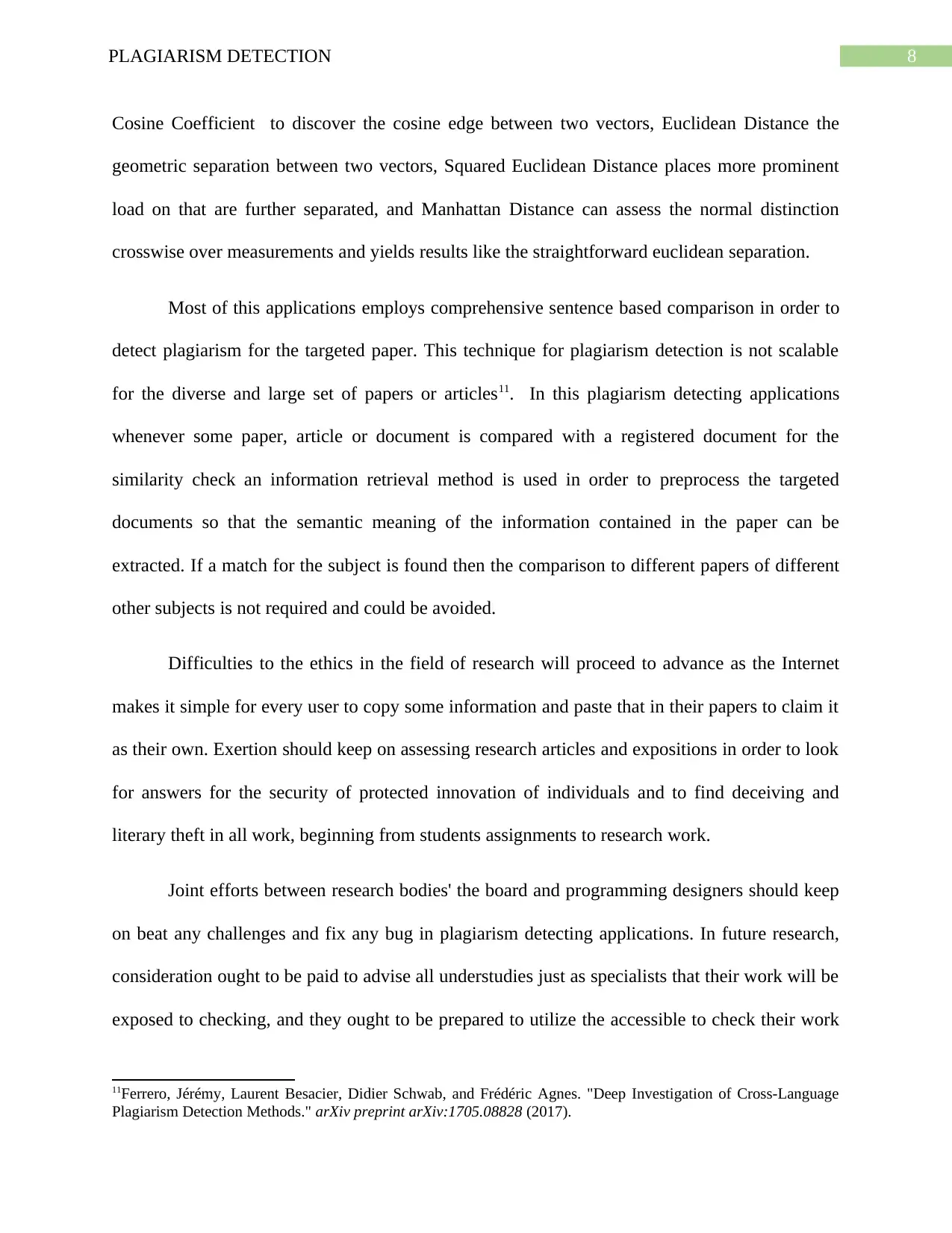
8PLAGIARISM DETECTION
Cosine Coefficient to discover the cosine edge between two vectors, Euclidean Distance the
geometric separation between two vectors, Squared Euclidean Distance places more prominent
load on that are further separated, and Manhattan Distance can assess the normal distinction
crosswise over measurements and yields results like the straightforward euclidean separation.
Most of this applications employs comprehensive sentence based comparison in order to
detect plagiarism for the targeted paper. This technique for plagiarism detection is not scalable
for the diverse and large set of papers or articles11. In this plagiarism detecting applications
whenever some paper, article or document is compared with a registered document for the
similarity check an information retrieval method is used in order to preprocess the targeted
documents so that the semantic meaning of the information contained in the paper can be
extracted. If a match for the subject is found then the comparison to different papers of different
other subjects is not required and could be avoided.
Difficulties to the ethics in the field of research will proceed to advance as the Internet
makes it simple for every user to copy some information and paste that in their papers to claim it
as their own. Exertion should keep on assessing research articles and expositions in order to look
for answers for the security of protected innovation of individuals and to find deceiving and
literary theft in all work, beginning from students assignments to research work.
Joint efforts between research bodies' the board and programming designers should keep
on beat any challenges and fix any bug in plagiarism detecting applications. In future research,
consideration ought to be paid to advise all understudies just as specialists that their work will be
exposed to checking, and they ought to be prepared to utilize the accessible to check their work
11Ferrero, Jérémy, Laurent Besacier, Didier Schwab, and Frédéric Agnes. "Deep Investigation of Cross-Language
Plagiarism Detection Methods." arXiv preprint arXiv:1705.08828 (2017).
Cosine Coefficient to discover the cosine edge between two vectors, Euclidean Distance the
geometric separation between two vectors, Squared Euclidean Distance places more prominent
load on that are further separated, and Manhattan Distance can assess the normal distinction
crosswise over measurements and yields results like the straightforward euclidean separation.
Most of this applications employs comprehensive sentence based comparison in order to
detect plagiarism for the targeted paper. This technique for plagiarism detection is not scalable
for the diverse and large set of papers or articles11. In this plagiarism detecting applications
whenever some paper, article or document is compared with a registered document for the
similarity check an information retrieval method is used in order to preprocess the targeted
documents so that the semantic meaning of the information contained in the paper can be
extracted. If a match for the subject is found then the comparison to different papers of different
other subjects is not required and could be avoided.
Difficulties to the ethics in the field of research will proceed to advance as the Internet
makes it simple for every user to copy some information and paste that in their papers to claim it
as their own. Exertion should keep on assessing research articles and expositions in order to look
for answers for the security of protected innovation of individuals and to find deceiving and
literary theft in all work, beginning from students assignments to research work.
Joint efforts between research bodies' the board and programming designers should keep
on beat any challenges and fix any bug in plagiarism detecting applications. In future research,
consideration ought to be paid to advise all understudies just as specialists that their work will be
exposed to checking, and they ought to be prepared to utilize the accessible to check their work
11Ferrero, Jérémy, Laurent Besacier, Didier Schwab, and Frédéric Agnes. "Deep Investigation of Cross-Language
Plagiarism Detection Methods." arXiv preprint arXiv:1705.08828 (2017).
⊘ This is a preview!⊘
Do you want full access?
Subscribe today to unlock all pages.

Trusted by 1+ million students worldwide
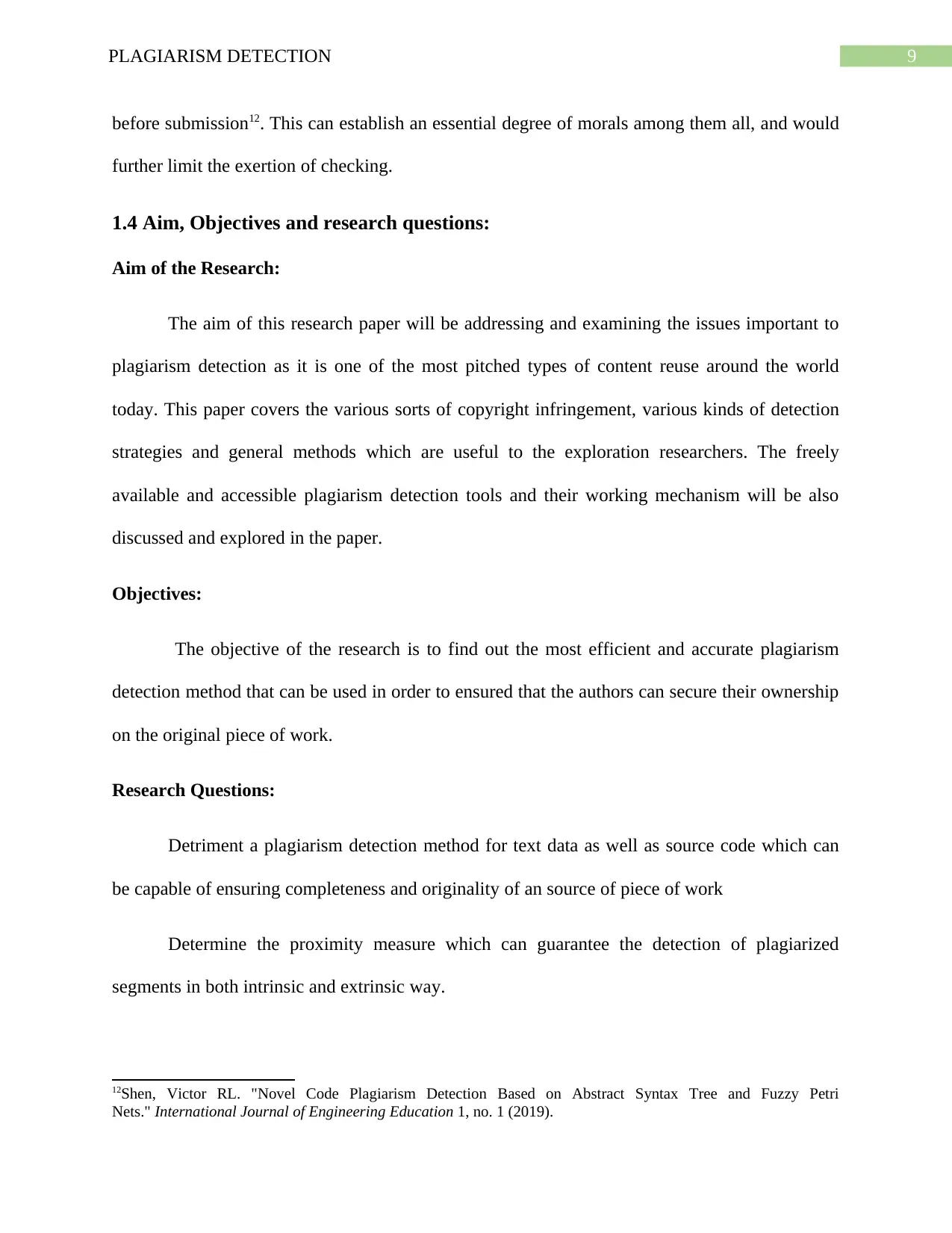
9PLAGIARISM DETECTION
before submission12. This can establish an essential degree of morals among them all, and would
further limit the exertion of checking.
1.4 Aim, Objectives and research questions:
Aim of the Research:
The aim of this research paper will be addressing and examining the issues important to
plagiarism detection as it is one of the most pitched types of content reuse around the world
today. This paper covers the various sorts of copyright infringement, various kinds of detection
strategies and general methods which are useful to the exploration researchers. The freely
available and accessible plagiarism detection tools and their working mechanism will be also
discussed and explored in the paper.
Objectives:
The objective of the research is to find out the most efficient and accurate plagiarism
detection method that can be used in order to ensured that the authors can secure their ownership
on the original piece of work.
Research Questions:
Detriment a plagiarism detection method for text data as well as source code which can
be capable of ensuring completeness and originality of an source of piece of work
Determine the proximity measure which can guarantee the detection of plagiarized
segments in both intrinsic and extrinsic way.
12Shen, Victor RL. "Novel Code Plagiarism Detection Based on Abstract Syntax Tree and Fuzzy Petri
Nets." International Journal of Engineering Education 1, no. 1 (2019).
before submission12. This can establish an essential degree of morals among them all, and would
further limit the exertion of checking.
1.4 Aim, Objectives and research questions:
Aim of the Research:
The aim of this research paper will be addressing and examining the issues important to
plagiarism detection as it is one of the most pitched types of content reuse around the world
today. This paper covers the various sorts of copyright infringement, various kinds of detection
strategies and general methods which are useful to the exploration researchers. The freely
available and accessible plagiarism detection tools and their working mechanism will be also
discussed and explored in the paper.
Objectives:
The objective of the research is to find out the most efficient and accurate plagiarism
detection method that can be used in order to ensured that the authors can secure their ownership
on the original piece of work.
Research Questions:
Detriment a plagiarism detection method for text data as well as source code which can
be capable of ensuring completeness and originality of an source of piece of work
Determine the proximity measure which can guarantee the detection of plagiarized
segments in both intrinsic and extrinsic way.
12Shen, Victor RL. "Novel Code Plagiarism Detection Based on Abstract Syntax Tree and Fuzzy Petri
Nets." International Journal of Engineering Education 1, no. 1 (2019).
Paraphrase This Document
Need a fresh take? Get an instant paraphrase of this document with our AI Paraphraser
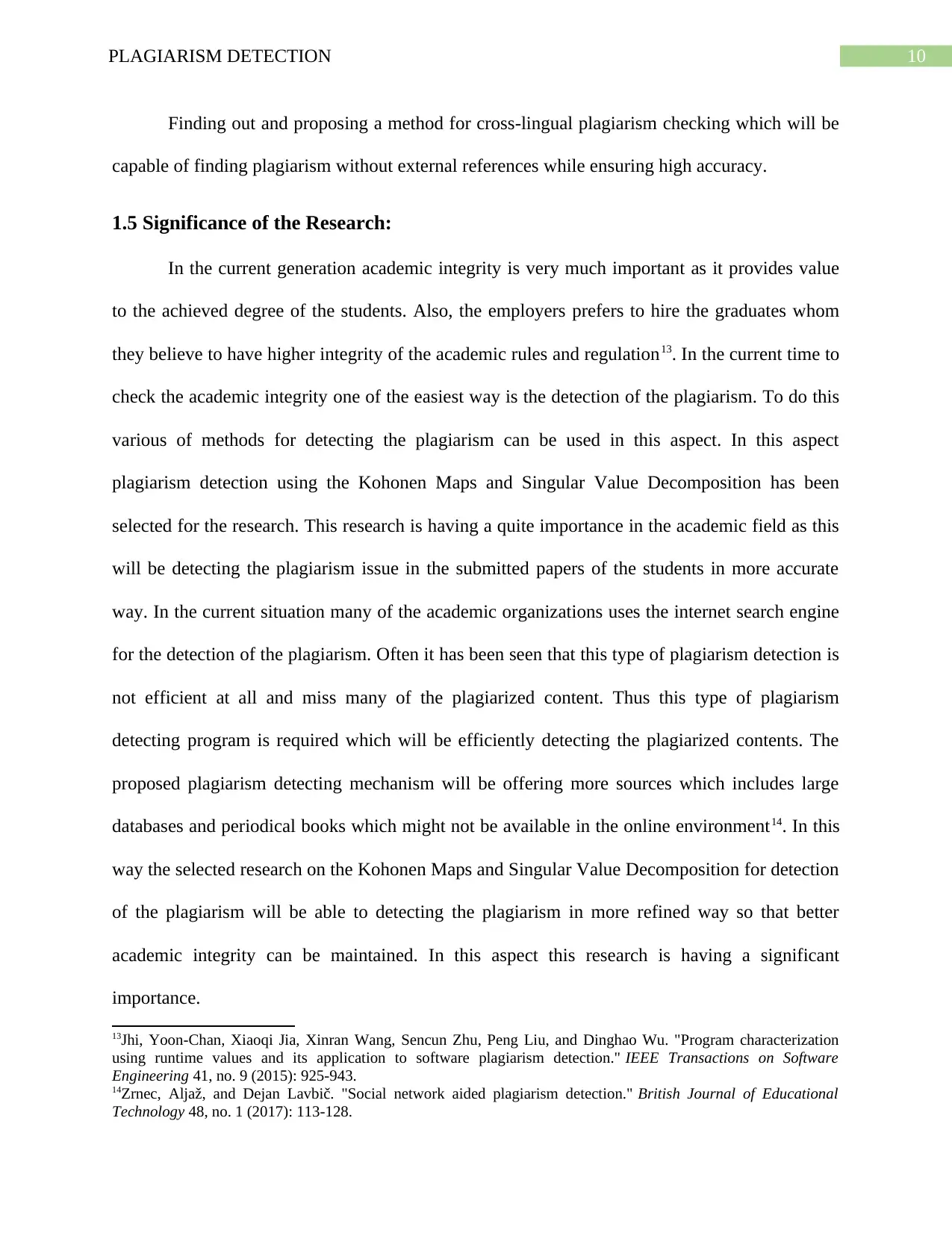
10PLAGIARISM DETECTION
Finding out and proposing a method for cross-lingual plagiarism checking which will be
capable of finding plagiarism without external references while ensuring high accuracy.
1.5 Significance of the Research:
In the current generation academic integrity is very much important as it provides value
to the achieved degree of the students. Also, the employers prefers to hire the graduates whom
they believe to have higher integrity of the academic rules and regulation13. In the current time to
check the academic integrity one of the easiest way is the detection of the plagiarism. To do this
various of methods for detecting the plagiarism can be used in this aspect. In this aspect
plagiarism detection using the Kohonen Maps and Singular Value Decomposition has been
selected for the research. This research is having a quite importance in the academic field as this
will be detecting the plagiarism issue in the submitted papers of the students in more accurate
way. In the current situation many of the academic organizations uses the internet search engine
for the detection of the plagiarism. Often it has been seen that this type of plagiarism detection is
not efficient at all and miss many of the plagiarized content. Thus this type of plagiarism
detecting program is required which will be efficiently detecting the plagiarized contents. The
proposed plagiarism detecting mechanism will be offering more sources which includes large
databases and periodical books which might not be available in the online environment14. In this
way the selected research on the Kohonen Maps and Singular Value Decomposition for detection
of the plagiarism will be able to detecting the plagiarism in more refined way so that better
academic integrity can be maintained. In this aspect this research is having a significant
importance.
13Jhi, Yoon-Chan, Xiaoqi Jia, Xinran Wang, Sencun Zhu, Peng Liu, and Dinghao Wu. "Program characterization
using runtime values and its application to software plagiarism detection." IEEE Transactions on Software
Engineering 41, no. 9 (2015): 925-943.
14Zrnec, Aljaž, and Dejan Lavbič. "Social network aided plagiarism detection." British Journal of Educational
Technology 48, no. 1 (2017): 113-128.
Finding out and proposing a method for cross-lingual plagiarism checking which will be
capable of finding plagiarism without external references while ensuring high accuracy.
1.5 Significance of the Research:
In the current generation academic integrity is very much important as it provides value
to the achieved degree of the students. Also, the employers prefers to hire the graduates whom
they believe to have higher integrity of the academic rules and regulation13. In the current time to
check the academic integrity one of the easiest way is the detection of the plagiarism. To do this
various of methods for detecting the plagiarism can be used in this aspect. In this aspect
plagiarism detection using the Kohonen Maps and Singular Value Decomposition has been
selected for the research. This research is having a quite importance in the academic field as this
will be detecting the plagiarism issue in the submitted papers of the students in more accurate
way. In the current situation many of the academic organizations uses the internet search engine
for the detection of the plagiarism. Often it has been seen that this type of plagiarism detection is
not efficient at all and miss many of the plagiarized content. Thus this type of plagiarism
detecting program is required which will be efficiently detecting the plagiarized contents. The
proposed plagiarism detecting mechanism will be offering more sources which includes large
databases and periodical books which might not be available in the online environment14. In this
way the selected research on the Kohonen Maps and Singular Value Decomposition for detection
of the plagiarism will be able to detecting the plagiarism in more refined way so that better
academic integrity can be maintained. In this aspect this research is having a significant
importance.
13Jhi, Yoon-Chan, Xiaoqi Jia, Xinran Wang, Sencun Zhu, Peng Liu, and Dinghao Wu. "Program characterization
using runtime values and its application to software plagiarism detection." IEEE Transactions on Software
Engineering 41, no. 9 (2015): 925-943.
14Zrnec, Aljaž, and Dejan Lavbič. "Social network aided plagiarism detection." British Journal of Educational
Technology 48, no. 1 (2017): 113-128.
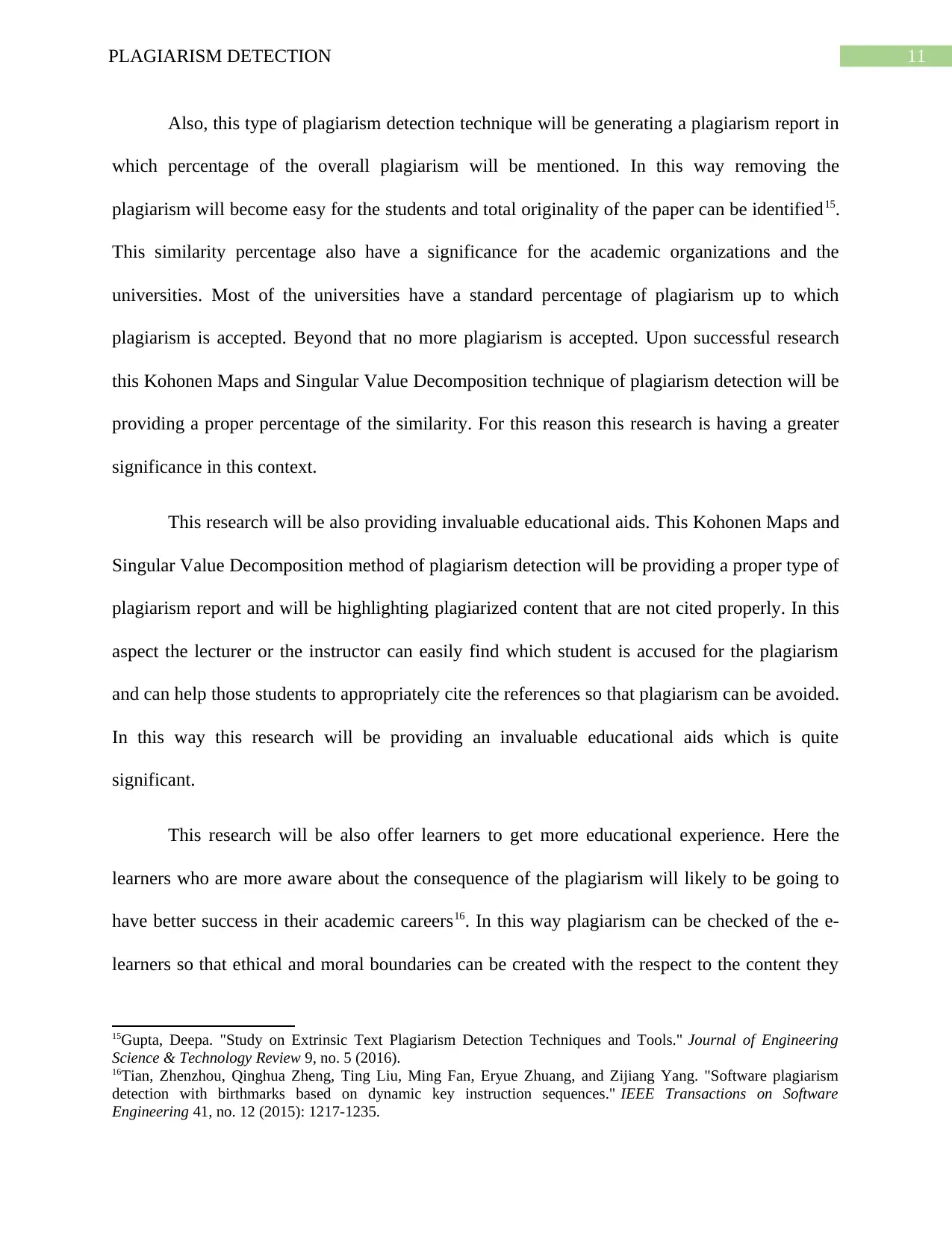
11PLAGIARISM DETECTION
Also, this type of plagiarism detection technique will be generating a plagiarism report in
which percentage of the overall plagiarism will be mentioned. In this way removing the
plagiarism will become easy for the students and total originality of the paper can be identified15.
This similarity percentage also have a significance for the academic organizations and the
universities. Most of the universities have a standard percentage of plagiarism up to which
plagiarism is accepted. Beyond that no more plagiarism is accepted. Upon successful research
this Kohonen Maps and Singular Value Decomposition technique of plagiarism detection will be
providing a proper percentage of the similarity. For this reason this research is having a greater
significance in this context.
This research will be also providing invaluable educational aids. This Kohonen Maps and
Singular Value Decomposition method of plagiarism detection will be providing a proper type of
plagiarism report and will be highlighting plagiarized content that are not cited properly. In this
aspect the lecturer or the instructor can easily find which student is accused for the plagiarism
and can help those students to appropriately cite the references so that plagiarism can be avoided.
In this way this research will be providing an invaluable educational aids which is quite
significant.
This research will be also offer learners to get more educational experience. Here the
learners who are more aware about the consequence of the plagiarism will likely to be going to
have better success in their academic careers16. In this way plagiarism can be checked of the e-
learners so that ethical and moral boundaries can be created with the respect to the content they
15Gupta, Deepa. "Study on Extrinsic Text Plagiarism Detection Techniques and Tools." Journal of Engineering
Science & Technology Review 9, no. 5 (2016).
16Tian, Zhenzhou, Qinghua Zheng, Ting Liu, Ming Fan, Eryue Zhuang, and Zijiang Yang. "Software plagiarism
detection with birthmarks based on dynamic key instruction sequences." IEEE Transactions on Software
Engineering 41, no. 12 (2015): 1217-1235.
Also, this type of plagiarism detection technique will be generating a plagiarism report in
which percentage of the overall plagiarism will be mentioned. In this way removing the
plagiarism will become easy for the students and total originality of the paper can be identified15.
This similarity percentage also have a significance for the academic organizations and the
universities. Most of the universities have a standard percentage of plagiarism up to which
plagiarism is accepted. Beyond that no more plagiarism is accepted. Upon successful research
this Kohonen Maps and Singular Value Decomposition technique of plagiarism detection will be
providing a proper percentage of the similarity. For this reason this research is having a greater
significance in this context.
This research will be also providing invaluable educational aids. This Kohonen Maps and
Singular Value Decomposition method of plagiarism detection will be providing a proper type of
plagiarism report and will be highlighting plagiarized content that are not cited properly. In this
aspect the lecturer or the instructor can easily find which student is accused for the plagiarism
and can help those students to appropriately cite the references so that plagiarism can be avoided.
In this way this research will be providing an invaluable educational aids which is quite
significant.
This research will be also offer learners to get more educational experience. Here the
learners who are more aware about the consequence of the plagiarism will likely to be going to
have better success in their academic careers16. In this way plagiarism can be checked of the e-
learners so that ethical and moral boundaries can be created with the respect to the content they
15Gupta, Deepa. "Study on Extrinsic Text Plagiarism Detection Techniques and Tools." Journal of Engineering
Science & Technology Review 9, no. 5 (2016).
16Tian, Zhenzhou, Qinghua Zheng, Ting Liu, Ming Fan, Eryue Zhuang, and Zijiang Yang. "Software plagiarism
detection with birthmarks based on dynamic key instruction sequences." IEEE Transactions on Software
Engineering 41, no. 12 (2015): 1217-1235.
⊘ This is a preview!⊘
Do you want full access?
Subscribe today to unlock all pages.

Trusted by 1+ million students worldwide
1 out of 19
Your All-in-One AI-Powered Toolkit for Academic Success.
+13062052269
info@desklib.com
Available 24*7 on WhatsApp / Email
![[object Object]](/_next/static/media/star-bottom.7253800d.svg)
Unlock your academic potential
Copyright © 2020–2025 A2Z Services. All Rights Reserved. Developed and managed by ZUCOL.